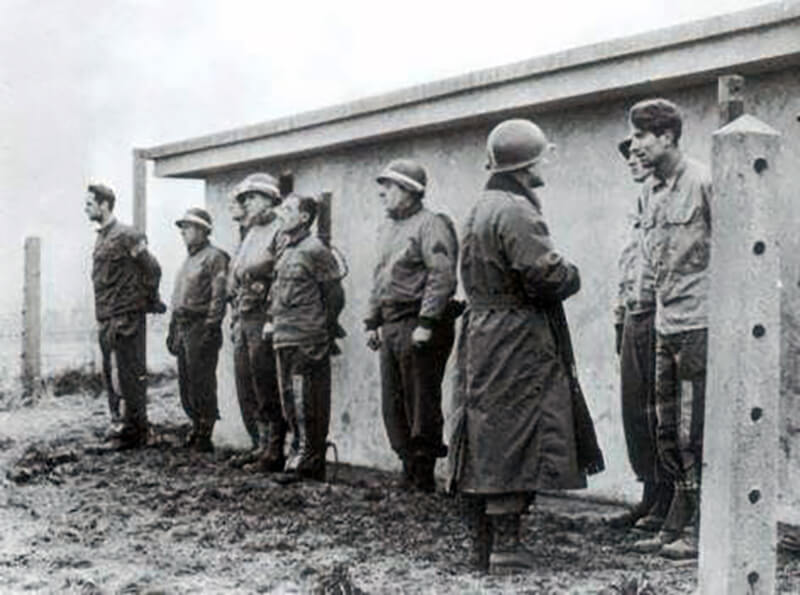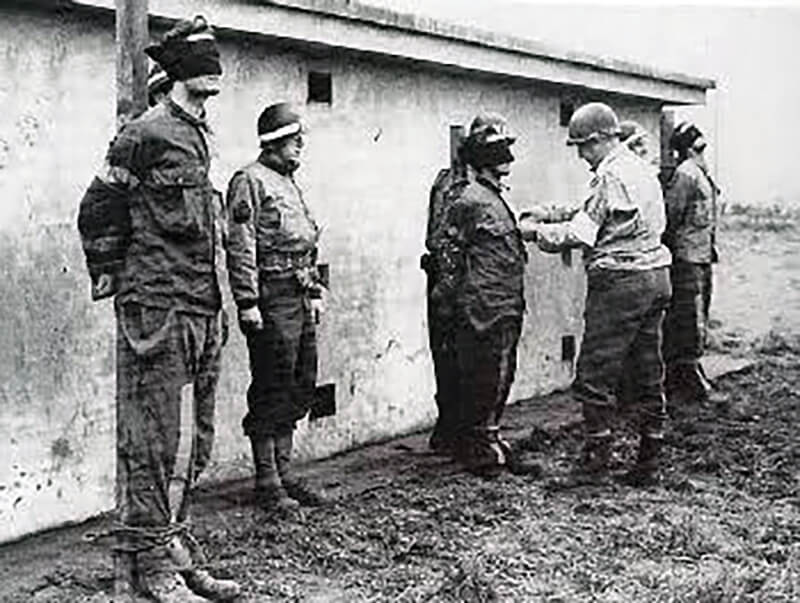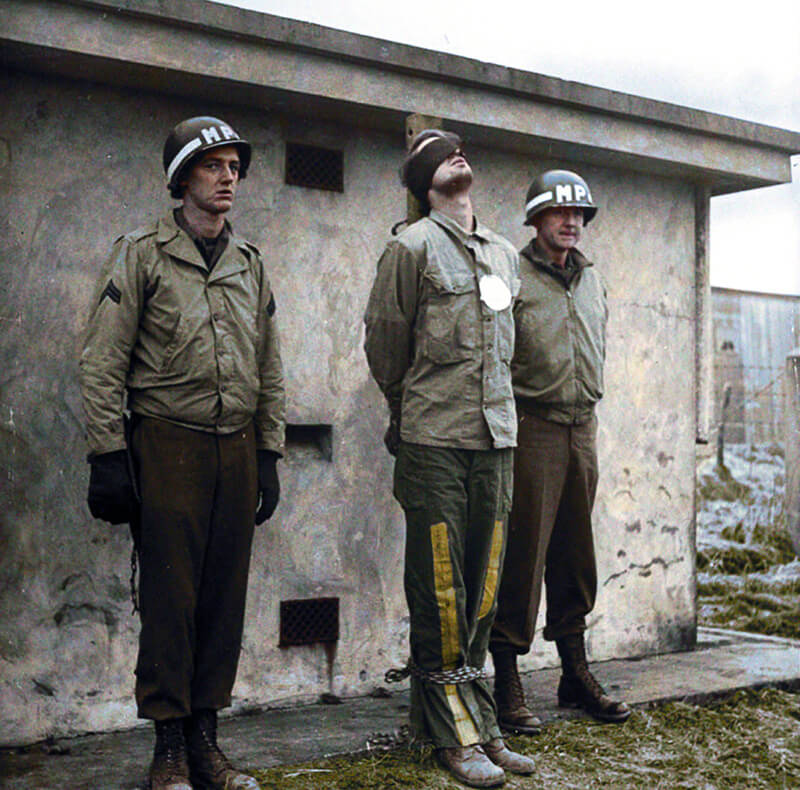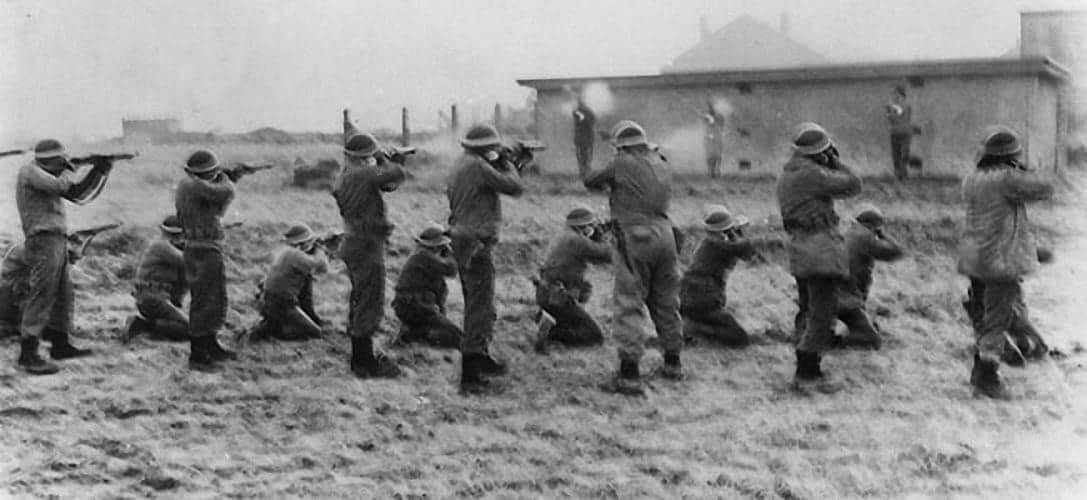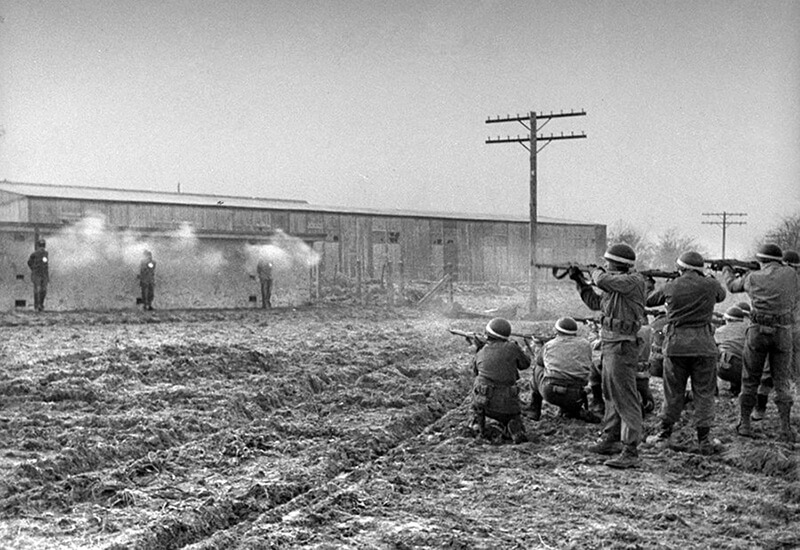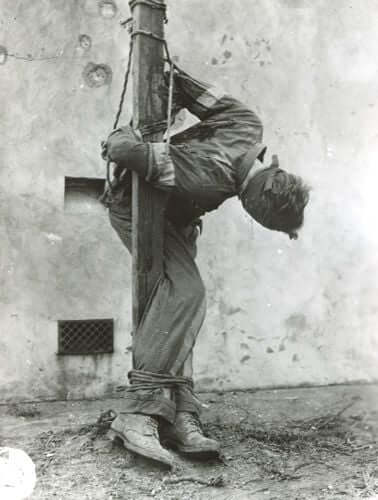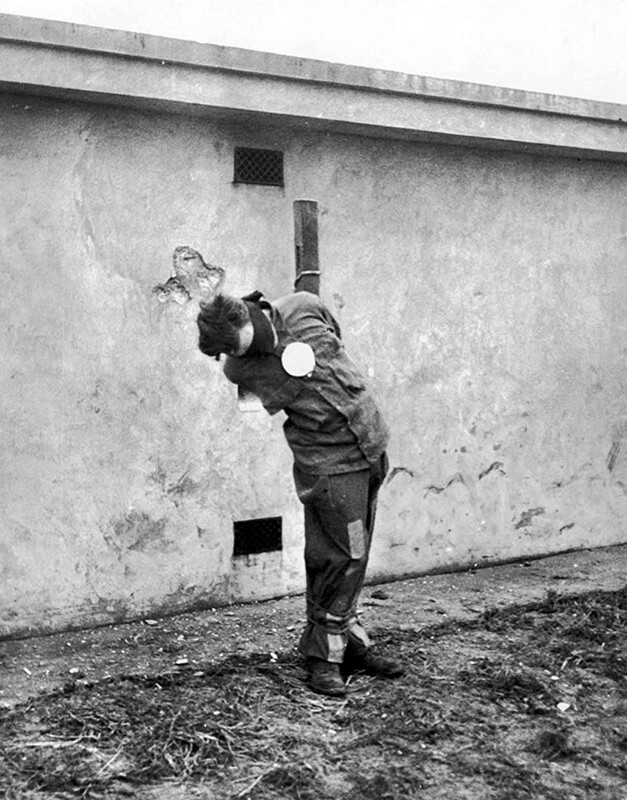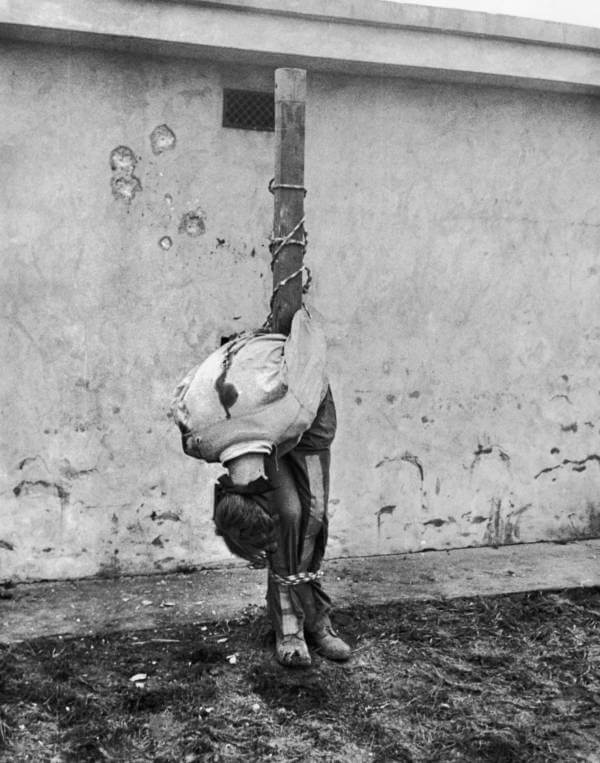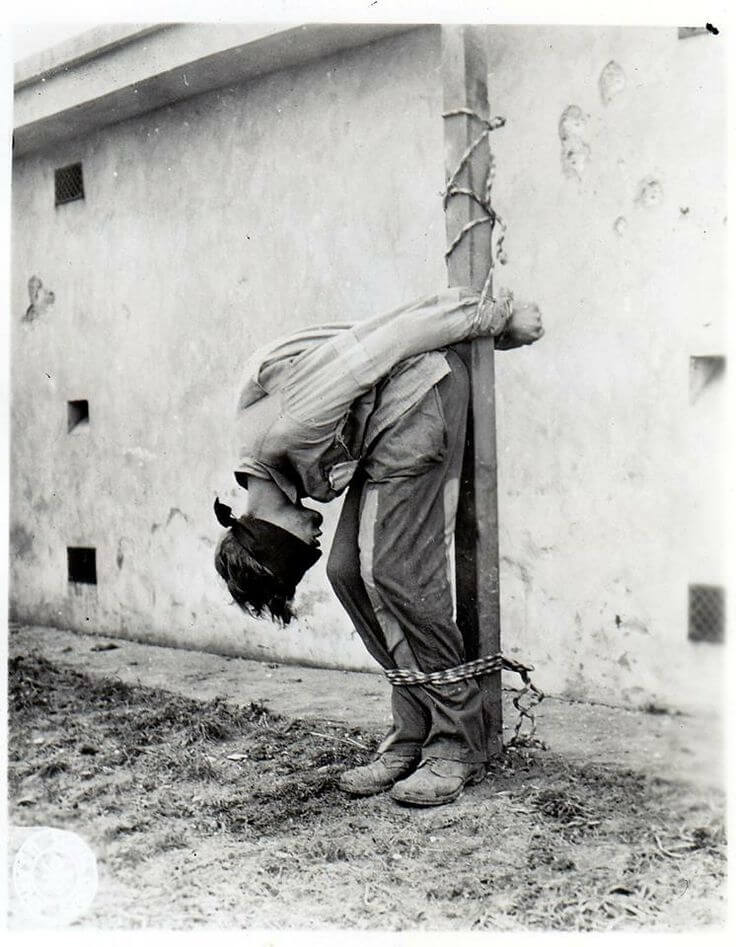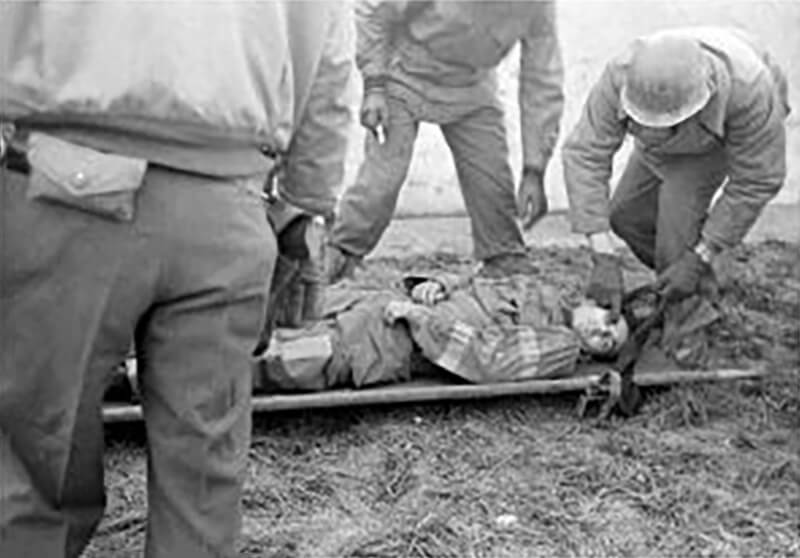| Page Created |
| August 7th, 2023 |
| Last Updated |
| August 7th, 2023 |
| Germany |
 |
| Special Forces |
| Panzer-Brigade 150 Einheit Stielau |
| December 1944 |
| Unternehmen Greif |
| Objectives |
- The seizure intact of at least two bridges across the Meuse by disguised raiding parties.
- The prompt reinforcement of any such coup de main by an armored commando formation.
- An organised attempt to create confusion in the Allied rear areas through sabotage carried out by jeep parties clad in American uniforms.
| Operational Area |
Malmédy Region, Belgium
| Unit Force |
Kampfgruppe Skorzeny
- Panzer-Brigade 150
- Brigade Stab
- Brigade Stab
- 14 men
- 26 men
- 22 men
- 62 men
- Nachschubabteilung
- 69 men
- Brigade Stab
- Kampfgruppe X (SS-Obersturmbannführer Willi Hardieck)
- Stab
- 10 men
- 3 x Infanterie Kompanien(Fallschirmjäger-Bataillon Schluckebier)
- 405 men
- 2 x Panzergrenadieren Kompanien
- 100 men
- 2 x Panzerabwehr Kompanien
- 60 men
- 2 x Schwere Granatwerfer Truppe
- 76 men
- Instandsetzungszug
- 25 men
- Nachrichtenabteilung
- 22 men
- Pionierabteilung
- 34 men
- Panzerabteilung
- 130 men
- 5 Ersatz Panthers
- 1 Sherman, American
- Stab
- Kampfgruppe Y (Hauptmann Walter Scherff)
- Stab
- 10 men
- 3 x Infanterie Kompanien
- 405 men
- 2 x Panzergrenadieren
- 100 men
- 2 x Panzerabwehr Kompanien
- 60 men
- 2 x Schwere Granatwerfer Truppe
- 76 men
- Instandsetzungszug
- 25 men
- Nachrichtenabteilung
- 22 men
- Pionierabteilung
- 34 men
- Panzerabteilung
- 130 men
- 5 Sturmgeschütz III G
- Stab
- Kampfgruppe Z (Oberstleutnant Hermann Wolf)
- Stab
- 10 men
- 3 x Infanterie Kompanien
- 405 men
- 2 x Panzergrenadier Kompanien
- 100 men
- 2 x Panzerabwehr Kompanien
- 60 men
- 2 x Schwere Granatwerfer Trupps
- 76 men
- Instandsetzungszug
- 25 men
- Nachrichtenabteilung
- 10 men
- PionierAbteilung
- 35 men
- Stab
- Einheit Stielau (Stielau)
- 150-160 men
- 24 Aufklärungskommandos
- 8 Funkkommandos
- 7 Pionierkommandos
- 150-160 men
| Opposing Forces |
- 6th Infantry Division
- 3rd Battalion of the 20th Infantry Regiment
- 30th Infantry Division
- 120th Infantry Regiment
- 84th Infantry Division
- 99th Infantry Battalion (separate)
- 291st Engineers Combat Battalion
| Einheit Stielau |
| October 22nd, 1944 |
Hitler summons Skorzeny to his headquarters at Rastenburg in East Prussia to discuss the upcoming Ardennes Offensive and Skorzeny’s role within it. Hitler perceives this offensive as a pivotal moment.
Hitler assigns Skorzeny the task of organising and instructing a specialised commando unit that would operate in conjunction with the 6. Panzer-Armee. This army is slated to lead the northern thrust of the operation, known as Unternehmen Wacht Am Rhein.
In this meeting, Hitler conveys that Skorzeny’s unit would play a crucial part in the offensive. Their mission involves advancing to the forefront and capturing one or more bridges spanning the Meuse River between Liege and Namur. To achieve this, Hitler proposes that his troops don British and American uniforms. He explains that the Allies have inflicted significant damage on the Germans by employing German uniforms in various commando operations. Hitler names a recent report which indicates that the use of German uniforms by an American force has had notably contributed to the capture of the town of Aachen a few days prior. Aachen marked the first German town in the western region to be occupied by the Allied.
Hitler envisions that the deployment of detachments dressed in enemy uniforms can create substantial confusion among the Allies. These units can issue false orders, disrupt communication channels, mislead Allied forces, and redirect troop movements in erroneous directions. Skorzeny receives an order to complete his preparations no later than December 2nd, 1944, while coordinating all intricate aspects of his unit and the operation with Generaloberst Alfred Jodl.
Skorzeny encounters two significant challenges during his operations: the imperative of maintaining absolute secrecy and adhering to the established rules of war. Hitler’s insistence on total secrecy prevents Skorzeny from disclosing his forces’ actual mission or coordinating with corresponding conventional units until shortly before the offensive commences.
Moreover, the decision to use Allied uniforms presents obstacles. This choice deprives Skorzeny’s force of the protection typically afforded to prisoners of war, potentially resulting in their execution as spies if captured. In response, Hitler directs that Skorzeny’s commandos wear their German uniforms underneath the American clothing. It is emphasised that they should not engage in combat while wearing Allied uniforms; in essence, the Allied attire is to be removed before any fighting occurred. The understanding is that posing as American soldiers will only violate the laws of war if the German troops fight while maintaining their disguises.
| October 25th, 1944 |
Just four days after receiving Hitler’s directive, Otto Skorzeny presents his plans for the establishment of Panzer-Brigade 150 to Generaloberst Alfred Jodl. Despite his request for a contingent of 3,300 men, Skorzeny promptly receives approval and comprehensive support for his ambitious undertaking.
Skorzeny’s mission plan can be summarised as follows: Kampfgruppe Skorzeny is entrusted with the task of infiltrating a designated zone to capture the Meuse River bridges at Andenne, Amay, and Huy. This objective is pivotal to ensure the unobstructed advancement of the 6. Panzer-Armee across the Meuse River while concurrently engaging in unconventional warfare operations to disrupt enemy defenses within the operational area. Kampfgruppe Skorzeny comprises two units: Panzer-Brigade 150, equipped with American vehicles and equipment, and a commando unit consisting of English-speaking German soldiers (ideally fluent in American slang), attired in American uniforms and equipped with jeeps.
While the operational concept isn’t overly intricate, its execution presents challenges. Each of the three battalions (also named Kampfgruppe) of Panzer-Brigade 150 closely trails one of the three leading divisions of the I. SS-Panzer-Korps as they breach enemy lines and advance through the initial penetration. These battalions shadow the foremost elements of the 1. SS-Panzer-Division, 12. SS-Panzer-Division, and 12. SS-Volksgrenadier-Division, progressing westward until reaching the Hohen Venn Ridge. There, the kampfgruppen of Panzer Brigade 150 manoeuvres through or alongside the lead panzer regiments. The three smaller Kampfgruppen, designated as Kampfgruppe X, Kampfgruppe Y, and Kampfgruppe Z, then advance separately toward the specified bridge objectives labeled as X, Y, and Z.
Commando teams in jeeps precede the leading divisions and the three Kampfgruppen to assess local enemy defenses. Independent commando units undertake limited acts of sabotage both ahead of and behind the primary force, aiming to disrupt enemy communication and sow confusion among defenders. Encounters with resistance are bypassed and reported, prioritising speed while preserving the Kampfgruppe’s limited combat strength for capturing and defending the targeted bridges.
Once secured, the bridges are to be held and subsequently transferred to the I SS-Panzer-Korps. Skorzeny’s commando teams are then poised to conduct additional acts of sabotage and deep reconnaissance to support the main offensive thrust. This sequence of operations is scheduled to occur no later than the second day of the offensive.
On the same day, the Oberkommando der Wehrmacht issues a directive seeking proficient soldiers with “knowledge of the English language and also the American dialect.” This directive is disseminated to almost every command post along the Western Front.
Selected individuals are dispatched to Skorzeny’s headquarters at Friedenthal, located roughly two kilometers away from the Concentration Camp in Oranienburg. Here, they undergo a linguistic assessment conducted by a board composed of three officers representing the SS, Luftwaffe, and Navy. The officers categorize the men based on their proficiency in American English, classifying them into four distinct groups:
- Fluent Communicators with American Slang Acumen (10 men): Individuals demonstrating impeccable language skills and an intimate understanding of slang expressions.
- Fluent Communicators without American Slang (30-40 men): Troops proficient in speaking English fluently, though lacking extensive knowledge of colloquialisms.
- Competent Speakers (120-150 men): Individuals showcasing commendable conversational abilities in American English, though not attaining the fluency levels of the preceding categories.
- Basic Proficiency (200 men): Individuals possessing a foundational grasp of English, often acquired through formal education.
This meticulous categorisation ensures strategic deployment of linguistic talents within the diverse landscape of Unternehmen Greif. While it remains unclear precisely how many men are assigned to the Kommando Einheit, sources suggest that between 150 and 160 men eventually join the unit. It is apparent that these individuals belong to the first three groups. Ten men from the first group are directly dispatched to Grafenwöhr, Germany, which serves as the heavily guarded headquarters of Panzer-Brigade 150 and the Kommando Einheit.
The remaining selected individuals destined for the Kommando Einheit are sent to American Prisoner of War camps at Küstrin and Limburg an der Lahn, both located in Germany. Here, they have the opportunity to interact with American Prisoners of War, further enhancing their language skills.
| Beginning of November 1944 |
Following their additional language training in the Prisoner of War Camps, the selected individuals are sent to Grafenwöhr for further instruction. The main trainer of this unit is Korvettenkapitän, Rittmeister of the Baltic Landwehr, Dipl.-Ing. chemist Philipp Baron von Behr. Various sources indicate that von Behr is fluent in English, although his accent is deemed too distinctively English for frontline use. His role will become significant later in the story.
At this point, the unit is known as Kommando-Kompanie von Behr, under the joint leadership of Korvettenkapitän von Behr and an SS officer named Stielau. While there’s some ambiguity, SS-Obersturmführer Horst Stielau is often mentioned as the commander. However, there are references to two more names: Oberleutnant Lothar Stielau and Ernst Stielau. It’s likely that Ernst and Horst Stielau are the same person, with the name being misreported. Oberleutnant Lothar Stielau, on the other hand, is known for his proficiency in French and is strongly linked to Stab Solar, Otto Skorzeny’s codename.
Coming from diverse branches of the German military, only a few of the selected men possess prior experience in undercover operations or sabotage. Due to the limited timeframe, they receive condensed training in demolition and radio skills.
The initial phase of training revolves around perfecting their portrayal of authentic American GIs. The members of the Stielau unit meticulously refine their English-speaking abilities, concentrating on mastering American soldier jargon and colloquialisms. They immerse themselves in American weaponry, equipment, literature, and films.
Integral to their preparation is the meticulous rehearsal of their assumed American identities, along with intensive training in driving and operating American jeeps. Radio operators undergo specialized instruction in effectively using their radio sets. For those lacking combat skills, crash courses cover close-quarters combat, sabotage tactics, reconnaissance techniques, handling plastic explosives, and proficient use of newly acquired silenced machine pistols.
At Grafenwöhr, the men are organised into 24 Aufklärungskommandos (reconnaissance teams), 8 Funkkommandos (radio reconnaissance teams), and 7 Pionierkommandos (pioneer teams). Each team specialises in distinct tasks:
- Aufklärungskommandos: Comprising three to four members, these teams work closely with the attacking leading divisions and the battalions of the 150 Panzer Brigade. They engage in reconnaissance roles, disrupting enemy leadership by cutting telephone wires, damaging radio stations, and issuing false commands.
- Funkkommandos: Consisting of three to four members, these units are tasked with reconnaissance both to the east and west of the Meuse River to monitor enemy tank, artillery, and unit movements. Some of these units are equipped with radios to transmit information about these movements. Like other teams, they also give false commands, alter road signs, remove minefield indicators, and mark streets with white stripes to simulate blocked roads.
- Pionierkommandos: Comprising five to six members, these teams are responsible for demolishing bridges, munition dumps, and gasoline storage facilities.
Within each of the specialised teams, specific roles are assigned to ensure the seamless execution of their mission. These roles include team commander, driver, saboteur or radio operator, and the crucial interpreter. The interpreter, being the sole member fluent in flawless English and American slang, holds a pivotal position.
Team members meticulously adopt a diverse array of unit types and ranks, including roles as high-ranking as an American colonel. Each participant is assigned a specific American identity to embody, with a strong focus on their connection to the U.S. 5th Armored Division. This comprehensive approach ensures their effective integration into the facade of the American military landscape, heightening the authenticity of their covert operations.
Each team employs jeeps for transportation and is outfitted in American uniforms and equipment. Four commando teams are assigned to each Kampfgruppe: two Aufklärungskommando teams, one Funkkommando team, and one Pionierkommando team. Additionally, one Aufklärungskommando is assigned to each of the three leading divisions. The remaining teams are designated for specific tasks within the operation.
| Beginning of December |
The first shipment of US weaponry and uniforms reaches Grafenwöhr. This shipment is accompanied by a convoy of thirty jeeps bearing random insignias from various US units. The arrival of both shipments reveals the true objective of Einheit Stielau. Not a single objection is raised against the mission.
| December 4th, 1944 |
A significant concern arises regarding the potential reinforcement posed by the substantial American forces situated to the north of the 6. Panzer-Armee. Field Marshal Model, in command of command of Heeresgruppe B and overseeing the offensive operations, devises an additional special operation, aimed at countering this threat.
Model’s proposal is for an airborne force to be deployed behind American lines in the Krinkelt/Rocherath region of Belgium. The objective is to impede enemy movements to the south, thus safeguarding the northern flank of the 6. Panzer-Armee. This strategic maneuver aims to thwart any potential advances by American forces that could have posed a significant challenge to the offensive’s success.
The dropzone is later changed by Hitler to the Hohes Vennen Area.
| December 5th, 1944 |
Panzer-Brigade 150 leaves their camp at Grafenwöhr and starts heading for Monschau-Eifel, Germany, the starting line of the brigade for Unternhemen Greif. To keep secrecy and prevent the brigade from being attack by aircraft the unit moves under the cover of the night.
| December 8th, 1944 |
Einheit Stielau also leaves Grafenwöhr and starts moving towards Monschau-Eifel. Like the Panzer Brigade they travel during the night.
| December 12th, 1944 |
During the late evening the members of Einheit Stielau start arriving in Monschau-Eifel. The group sets up camp in tents or nearby houses approximately one kilometre outside the town. During this time, additional US attire and official documents, including drivers’ licenses and pay books, were distributed.
On December 14, a convoy of twenty-nine jeeps, each carrying a squad of four men, set out towards Hallschlag and Stadtkyll in Germany where Stab Solar is stationed. Solar is Skorzeny’s cover name. Those who inadvertently missed departure caught up a day later. The entire contingent donned American uniforms and were armed with US weaponry. However, as a security measure, they were instructed for o wear German Paratroopers’ jump jackets while operating within German territory.
| December 14th, 1944 |
Having traveled under the cover of darkness, Panzer-Brigade 150 and Einheit Stielau arrive at its designated assembly area near Monschau-Eifel. Although the offensive is postponed several times, Skorzeny learns that operations will commence on December 16th, 1944. Skorzeny uses these days to train his troops to the highest standards and to coordinate their movements in accordance with the plans for the attack.
A convoy of 29 jeeps, each carrying a squad of four men, sets out towards Hallschlag and Stadtkyll, Germany where Stab Solar was stationed. The entire contingent donned American uniforms and were armed with US weaponry. However, as a security measure, they were instructed to wear German Paratroopers’ jump jackets while operating within German territory.
Each of three Kampfgruppe are joined by two Aufklärungskommandos, one Funkkommando and one Pionierkommando from Einheit Stielau.
| December 15th, 1944 |
One team who inadvertently missed departure catch up with the unit. The first operational units of Einheit Stielau move towards their starting point of Unternehmen Greif. Three lead teams move to the starting lines of the 1. SS-Panzer-Division, 12. SS-Panzer-Division, and 12. Volksgrenadier-Division. The rest of the unit travels towards Losheim, Germany where they establish their Headquarters.
That same day, in coordination with 6. Panzer-Armee, Skorzeny establishes his command post in close proximity to the headquarters of the 1. SS-Panzer-Korps at Schmidtheim, Germany.
| December 16th, 1944, Start of Unternehmen Greif |
At 05:00 on the early morning of Saturday, “Unternehmen Wacht am Rhein” begins with a significant artillery bombardment. Four Funkkommando teams and two Pionierkommando teams of Einheit Stielau immediately move behind enemy lines. Additionally, one group of Aufklärungskommando advances ahead of each of the leading assault divisions: the 1. SS-Panzer-Division, the 12. SS-Panzer-Division, and the 12. Volksgrenadier-Division. With these movements, Skorzeny initiates one part of Unternehmen Greif.
Two primary methods are employed to infiltrate behind enemy lines:
The first approach involves a jeep team closely trailing an advancing armored unit. As this unit engages American forces or breaches their lines, the jeep team diverts from the main road, navigating secondary roads and paths. This maneuver enables them to position themselves behind withdrawing or defending American troops.
The second technique is even more direct: the jeep team navigates through densely wooded areas using small trails or gaps in the American defenses until they successfully infiltrate behind enemy lines. Subsequently, they transition to established roads to carry out their assigned tasks.
As the teams move behind enemy lines around 07:00 in the morning, initial reports start arriving. Unfortunately, these reports are not optimistic. The enemy positions at Losheimer Graben seem to have weathered the artillery barrage, while the American defenders exhibit notable resilience, impeding or even halting the forward movement of the German forces. The pace of advancement by the leading divisions proves sluggish, and as midday approaches, the situation reports continue to depict fierce clashes, with minimal notable progress in territorial acquisition. The concern of a complete front-line collapse in the face of the initial assault remains unfulfilled.
Recognizing a delay of several hours, Skorzeny, positioned at his headquarters in Schmidtheim, Germany, questions the viability of the planned surprise maneuvers by his troops. To better understand the situation, he sets out in his Kubelwagen towards Losheim, Germany. He observes congested roads filled with various vehicles and notes officers walking beside their cars to manage traffic. Skorzeny himself walks around ten kilometers before reaching Losheim.
Faced with a critical decision, achieving the day’s objectives seems increasingly uncertain. The logical course of action would be to terminate “Unternehmen Greif.” However, Skorzeny entertains the idea of potential success if the armored divisions are activated during the night, potentially breaking through at the Hohe Venn crossroads. The prospect of Panzer-Brigade 150 reaching the Meuse River and securing the bridges remains.
From his commando unit, Einheit Stielau, Skorzeny selects three teams. He sends them in a southern direction, with specific instructions to identify a vulnerable point in the enemy’s frontline and maneuver through it skillfully. Stressing the importance of thorough reconnaissance, he highlights the three designated roads that the three Kampfgruppen are scheduled to use for their approach.
The actions of the teams of Einheit Stielau during this phase of the operation are not extensively documented, and following portraits have been constructed based on information from various sources.
| Funkkommando of Leutnant Collonia |
Leutnant Collonia and Feldwebel Heinz Rohde, the latter operating under the alias Sergeant Morris Woodahl, are assigned to infiltrate behind the 12th SS-Panzer-Division.
As they move behind enemy lines, they closely follow an advancing panzergroup. However, the panzergroup suddenly halts after just fifty meters, signaling that they have entered “no man’s land.” Collonia and Rohde swiftly shed their parachute smocks, while the jeep is still in motion. The driver manages to remove his gear in a remarkable acrobatic maneuver, all the while the jeep’s accelerator is kicked frantically and the co-driver struggles with the wheel to navigate around obstacles. They encounter a burning American truck, a result of the nearby panzer group. Soon after, they find themselves facing an American infantry group setting up an anti-tank gun directly in their path. Through quick reflexes, they manage to escape unharmed, albeit covered in mud.
Passing a military police officer stationed on the road, they are directed to a side road while suppressing enemy fire on the main route.
Continuing their journey, they eventually reach the Meuse River in their jeep. Successfully infiltrating the shattered frontlines, they arrive at the Meuse River near Huy. There, they position themselves near a road junction, covertly observing the enemy’s activities. Leveraging Collonia’s excellent English-speaking skills, he walks down the road to personally assess the situation. After a few hours, an unsuspecting tank regiment passes by, and its commander approaches Collonia for information. He provides the commander with misleading details, effectively deceiving him and further muddling the enemy’s understanding of the situation.
On their return journey, the team cuts a recently laid telephone cable and removes signposts intended for American supply units. After twenty-four hours, they successfully make their way back to the German lines near the 5. Panzer-Armee. There, they provide a firsthand account of the mission’s achievements, along with a detailed description of the chaos and confusion prevalent behind the American frontlines on the operation’s initial day. Subsequently, they return to Einheit Stielau’s headquarters in Losheim, Germany.
| Funkkommando of Fritz Bussinger |
This team achieves a remarkable feat by infiltrating more than 160 kilometers behind enemy lines. By tailing a retreating American convoy and skillfully navigating through multiple checkpoints, they manage to enter Huy, Belgium, on the evening of December 16th, 1944. In Huy, they successfully conduct reconnaissance of a crucial bridge over the Meuse River, a primary objective for both Panzer Brigade 150 and the 1. SS-Panzer-Korps. The team conducts both mounted and dismounted reconnaissance of the area, discovering that the bridge is guarded by only a small sentry detachment. They transmit this critical information back to the Stielau command post near Losheim, Germany.
During their time in Huy, team leader Fritz Bussinger has an encounter with the leader of an American armoured column. When asked for directions to the town of Marche, Bussinger informs the American leader that German forces have control over several roads in that vicinity, purposefully leading the convoy astray in the wrong direction.
Throughout the night and into the following day, December 17th, 1944, the team maintains vigilant surveillance of the bridge. As American searchlights begin sweeping the riverbanks, the team becomes concerned about potential exposure and requests permission to exfiltrate.
Once they receive the green light to withdraw from the Stielau headquarters that same day, the team deftly maneuvres through the columns of retreating American vehicles. Along their route, they strategically disrupt telephone cables and remove unit signposts. Upon safely returning, the team members debrief at the headquarters of the 5. Panzer-Armee, providing a comprehensive report that includes information about enemy positions, convoy movements, artillery emplacements, and the location of an ammunition depot near Huy.
| Funkkommando of Wilhelm Giel |
This team successfully infiltrates the vicinity of Liege, Belgium, home to another critical bridge target over the Meuse River. The team observes that the Allies have not implemented any special security measures at the Meuse River bridge. They also provide a detailed report on the overall situation around Liege. Notably, they observe American forces moving from Liege toward the battle area and indicate that the Americans appear to have evacuated their airfields east of the Meuse River. Additionally, the team discovers a sizable ammunition depot near Liege.
By donning Military Police insignia, team leader Wilhelm Giel leads an American infantry regiment of the 84th Infantry Division astray, causing a delay in its arrival at the battle zone. This account is substantiated by American sources, which confirm that the regiment’s movement was indeed disrupted.
Upon their return to German lines, the team engages in various acts of sabotage in addition to gathering valuable intelligence about enemy movements and defenses. They lay mines, obstruct roads with fallen trees, and set up mock minefield markers to hinder the movement of American reinforcements. These actions are aimed at slowing down and disrupting the American response.
| Pionierkommando of Leutnant Kohler |
The Pionierkommando team of Leutnant Kohler and Oberleutnant Wolfgang Schmidhuber engages in significant sabotage activities. This team reportedly discovers an ammunition depot and successfully detonates a substantial portion of it on the evening of December 16th, 1944. Additionally, they strategically sever a major telephone cable at multiple points. This cable is believed to have connected the American First Army Headquarters in Spa, Belgium, with the 12th Army Group in Namur. Its disruption causes a significant communications gap between General Hodges and General Bradley during a crucial phase of the initial battle.
There are indications that this team also plays a direct role in supporting the advance of Kampfgruppe Peiper. On the evening of December 17th, 1944, elements of the 5th Belgian Fusiliers Battalion and the American 291st Engineer Battalion observe unusual American soldiers near the Stavelot bridge in Belgium, preparing to destroy it. Although engineers from the American 202nd Engineer Battalion are indeed responsible for rigging the bridge for demolition, they are accompanied by numerous stragglers. Suspicious soldiers near the bridge are noticed by Belgian observers but not confronted.
It is a documented fact that when Peiper’s tanks later approach the bridge on the morning of December 18th, 1944, the explosive charges fail to detonate as intended during the American attempt to destroy the span. This successful intervention allows Peiper’s forces to swiftly capture Stavelot and maintain their westward progress. It is also known this team takes two American prisoners of war which they try to bring back to the German lines.
However, the team’s luck takes a turn for the worse on their return journey. On December 18th, 1944, they approach a roadblock manned by two American Military Policemen from Company B. The jeep with the four disguised German soldiers inside and two American (Prisoners of war) on the hood, appears like a normal group of American soldiers. However, when seeing the inscription “106” of the 106th Infantry Division, the American Military Policemen recognise it as a fake vehicle. Chaos erupts when Schmidhuber says something to the Military Policemen. Schmidhuber known for his poor English, was ordered during the mission’s briefing to say nothing. Him opening his mouth, leads the Americans to order him to raise his hands. The situation escalates, resulting in the Military Policemen opening fire. One of the captured Americans on the hood jumps off and shouts that the men inside the jeep are Germans. The other soldier also jumps off the hood and starts running for a safe place. This causes the Germans to open fire on the fleeing men and the American Military Policemen. Both Policemen are killed in the event. A machine gun at the roadblock starts firing at the Jeep. Schmidhuber is hit during the shooting. It is not entirely clear whether Schmidhuber is immediately dead or injured. According to data from the Deutsche Dienststelle, Wolfgang Schmidhuber dies on December 21st, 1944, at 03:14 in the morning, east of Malmedy. That suggests that he died three days after the shooting.
According to Skorzeny, the remaining three Germans manage to link up with Kampfgruppe Peiper, and on Christmas Eve, they succeed in crossing the main German lines at Wanne, east of Salm.
| Aufklärungskommando Poteaux |
Another documented story is about one of the Aufklärungskommando teams arriving at a village, most likely Poteaux, situated southwest of Ligneuville on the first day of Unternehmen Greif. In this village, two American companies are actively organising their defences, establishing roadblocks, and setting up machine-gun nests. The German team members receive quite a shock when an American officer asks them about the situation at the front. The German team leader, wearing the uniform of an American sergeant, tells the American officer that the Germans have passed through the village on both sides, effectively isolating it. The American officer appears to believe the story and subsequently orders a withdrawal. Fortunately for the team, the American officer only dispatches a scouting detachment to show them the open road leading westward. This fortunate turn of events allows the team to make their way back safely to their headquarters at Losheim.
| Redirection Operation |
Another team also successfully alters the course of an American infantry regiment’s movement towards the front lines. This team, disguised as American Military Police at the Mont Rigi road junction along the N27 highway from Liege, manipulates road signs and directs traffic incorrectly for several hours on December 17th, 9144. During this incident, the 16th Infantry Regiment of the 1st Infantry Division, en route to reinforce the southern front, is led off course to Malmédy instead of its intended destination of Waimes. Consequently, the regiment experiences a delay in reaching its designated defensive positions for that day. The redirection is discovered when genuine American MPs arrive to address the confusion, ultimately identifying the commando team at the road junction. The German commandos swiftly retreat as their jeep speeds away from the scene. Remarkably, it is reported that one of the commandos is still positioned on the jeep’s front bumper, holding onto wire cutters, from where he had been orchestrating the diversion.
| Aufklärungskommando of Baron von Behr |
Records and accounts of the opening days of Einheit Stielau do not provide information about the activities of one Aufklärungskommando team and one Funkkommando team. Despite being dispatched through the American lines, their contributions seem to have been minimal in comparison to their counterparts. These teams manage to re-enter German lines and eventually reunite with the rest of the Commando company.
Interestingly, it is known that one of these teams, led by the elderly naval officer named Korvettenkapitän, Rittmeister der baltischen Landeswehr, Dipl.–Ing. chem. Philipp Baron von Behr. enters the town of Malmedy on December 17th, 1944. It appears that this entry was unintentional, as von Behr has become disoriented and accidentally passes through Malmédy. During this encounter, von Behr notes a lack of significant defensive preparations in the town and that there are only service units in Malmédy. They return one day later wearing German uniforms reassessing the situation in Malmédy. This information leads Skorzeny’s units to launch an attack on Malmédy. His subsequent oral report to Skorzeny on December 19th, 1944, after the team successfully returns to German lines, had far-reaching consequences for the fate of Panzer Brigade 150.
| Gasoline storage facility |
Another unidentified commando team discovers a gasoline storage facility, the details of which are communicated to 1. SS-Panzer-Korps headquarters by Skorzeny, suggesting its potential use by the German armoured units. While Kampfgruppe Peiper does indeed replenish their fuel supply from an American fuel depot captured in Büllingen on December 17th, 1944, it cannot be definitively confirmed that this specific depot is the same one that the aforementioned commando team has reportedly located.
| Witnesses of Einheit Stielau |
The Americans and other witnesses also report acts of sabotage from Einheit Stielau. Sergeant Ed Keoghan of the 291st Engineers Combat Battalion reports that the road signs at the Mont Rigi intersection on the morning of December 17th, 1944, are changed. As a result, the 16th Regiment of the 1st US Infantry Division takes the longest route to Waimes.
However, there are also setbacks. A commando team attempting to surrender to the Americans discovers that they are speaking to a Military Policemen who are also part of Skorzeny’s commandos.
American army counterintelligence also plays a pivotal role in uncovering Einheit Stielau. On December 16th, 1944, members of the 106th Infantry Division stumble upon a confidential order outlining Unternehmen Greif on a deceased German soldier. Swiftly, the Counter Intelligence Corps (CIC) disseminates the information about the German deception plan and promptly enacts various security measures in response.
Among these measures are a series of posters, the establishment of roadblocks, checkpoints, vehicle spot-checks near the frontline, and an alert for identifying counterfeit U.S. Army uniforms. To distinguish genuine soldiers from potential infiltrators, the Counter Intelligence Corps recommends checkpoint guards to hold suspicious-looking individuals at gunpoint and ask them questions that only a true American soldiers would know the answers to. Examples included inquiries like “What is the price of an air mail stamp?” or “Who is Frank Sinatra?”
The Counter Intelligence Corps also employs accent tests by instructing soldiers to articulate words like “wreath” or “with” aloud. Given that the German language lacks the sound “th,” native German speakers would likely pronounce it as “s,” inadvertently revealing their non-American origin through their accent.
It didn’t take long before the first men of Einheit Stielau are arrested.
| Aufklärungskommando Team of Günther Billing, Manfred Pernass, and Wilhelm Schmidt |
On December 17th, 1944, an Aufklärungskommando team, providing support to the 1. SS-Panzer-Division, effectively infiltrates the American lines. By noon, they have advanced forty kilometres and reach the village of Aywaille, located in Belgium. However, their progress is halted when they encounter a military police checkpoint within the village. The team is asked to provide the day’s password as a security measure, but they are unable to comply with this request. According to their papers, their names are Charles W. Lawrence, Clarence van der Wert, and George Sensenbach. They confess to being German infiltrators belonging to a large unit operating behind American lines. Their real names are Günther Billing (21), Manfred Pernass (23), and Wilhelm Schmidt (24).
The three teammembers are dressed in American uniforms but lack field jackets and leggings, and only one wears the standard regulation belt. Although their military-type identification papers seem to be fine, they also have German personal documents on their person. Interestingly, they carry a German “Soldbuch” (A Pay Book), which is essentially a German personal military identification document. Each member carries a US M-19 11-A1 .45-caliber pistol. The equipment in their jeep is equally intriguing, encompassing two portable radios, two German MP-3008 Neumünster 9-milimeter submachine guns (German-made Sten Gun), a German 9-milimeter Walther P-38 pistol, and a collection of six German M-39 Eierhandgranate hand grenades. Alongside these armaments, they also carry US K-rations and ammunition in the jeep.
The men are arrested and brought in for interrogation. Here, Wilhelm Schmidt tells his interrogators that a unit of two or three hundred paratroopers is en route to Paris to capture Eisenhower. This is taken so seriously that Eisenhower is ordered to leave his headquarters, the former headquarters of Von Rundstedt, and is relocated to a headquarters in Versailles. For four days, Eisenhower is held captive by these baseless rumors.
| Killed In Action |
On December 18th, 1944, a German Commando team emerges from a forest path in a captured mechanized cannon from the American 18th Squadron of the 14th Cavalry Group, which has reached Poteau. They are stopped by troops from the 7th Armored Division, to which the 14th Cavalry belonged. Sergeant John S. Myers recounts that the men claim to be cavalrymen from “E Troop” and are subsequently killed near Poteau. They are recognized by Americans as German infiltrators since the American cavalry units are referred to as Troops by the Americans instead of companies.
Besides this account, there are photographs available of German Commandos lying dead beside a jeep. These pictures do not show a mechanized cannon. However, it is very likely that these deceased Germans are the men killed by the 7th Armored Division.
On December 21st, 1944, Jeep teams assigned to Kampfgruppe Y approach a roadblock at the bridge leading to the town of Malmédy. They are simulating part of a US unit which has been cut off. The objective of these teams is to neutralise the roadblock and thereby permit the rest of the group to take the objective.
About five kilometres from Ligneuville they cross into a minefield. The column halts, and American small arms fire and artillery zero in on them. The fire is devastating, and most of the captured American vehicles involved are destroyed. Only a few succeed in withdrawing.
| Aufklärungskommando Team of Günther Schulz, Manfred Bronny, Hans Reich and Karlheinz Weisenfeld |
Infiltrating the American lines with determination, an Aufklärungskommando team led by Officer Leutnant Günther Ernst Heinz Schulz, along with Manfred Bronny, Stabsgefreiter Hans Walter Otto Reich, and Leutnant Karlheinz Wilhelm Weisenfeld, almost reached their intended target: the bridge over the Meuse River between Huy and Namur.
However, their progress was halted by military policemen from C Company of the 769th Military Police Battalion at the N3 intersection with the Aachen-Liège canal. While talking to the team many small details didn’t match up. Suspicion arises when one of the men inside the jeep is searched and is found to store his documents in cellophane, an unusual practice for an American. His ID tag number also doesn’t correspond to the one he provided earlier. Inside the jeep the military policemen find explosives described as American mess tins filled with solid explosive material. Numerous detonators with electrical wires are also discovered. Besides that, the vehicle also holds two submachine guns, hand grenades, English and American currency, and a stack of thirty maps. Clothing discrepancies emerge: Bronny wears black German shoes, Weisenfeld and Reich are dressed in American uniforms, while Schulz is donned in a German sweater and undershirt beneath an American jacket and helmet. Perplexed by these inconsistencies, the policemen arrested the team.
| Team Alfred Franz, Antoni Morzuck, and Otto Struller, Team Josef Kania and Team Rolf Jesch, Heinrich Pipitz and Karl Müller |
In the aftermath of the Battle of Malmedy on December 21st, 1944, six members of Einheit Stielau are apprehended by members of the 30th Infantry Division. Obergefreiter Rolf Jesch, Unteroffizier Heinrich Pipitz, and Gefreiter Alfred Franz are captured together, while Obergefreiter Antoni J. Morzuck, Gefreiter Otto Struller, and Gefreiter Karl Müller are found in a Belgian house. Josef Kania is arrested alongside two members of Kampfgruppe Y. All men are likely survivors of the attack on the bridge to Malmedy earlier that day.
While Franz, Morzuck, and Struller are attired in American uniforms, Kania, Jesch, Pipitz, and Müller are taken into custody wearing German uniforms, classifying them as conventional prisoners of war.
| Team Krause, Artillery Reconnaissance |
In the late evening of December 22nd, 1944, two squads from Einheit Stielau comprising a seven-member group embark on a mission. Their primary objective is to locate and disable American artillery bombarding German territory near Bellevaux-Ligneuville. Their secondary mission involves gathering intelligence on American forces in the area. Their expected return is by the morning of December 23rd, 1944, potentially with captured American prisoners of war.
The team includes Leutnant Arno Krause, Leutnant zur See Günther Schilz, Maschineobermaat Horst Görlich, Obergefreiter Rolf Meyer, Unteroffizier Erhard Miegel, Obergefreiter Robert Pollack, and Obergefreiter Dietrich Wittsack. Attired in American uniforms, they carry a variety of American weaponry. Leutnant zur See Günther Schilz leads one team, while Leutnant Arno Krause commands the other.
Each team starts out traveling in a jeep. Upon reaching a certain point, they abandon their vehicles and proceed on foot. Roughly fifteen to twenty minutes beyond the last German outpost, just behind the American frontline in the Géromont area, an American soldier stationed at a doorway halts them for identification. Leutnant zur See Schilz and Leutnant Pollack initiate a conversation. The American’s suspicion escalates during the ensuing dialogue, leading to the disarmament and subsequent capture of both Germans. The American instructs the team commanders to summon the rest of their teams inside, resulting in their arrest as well. This occurs around 02:00 on December 23rd, 1944.
| Amidst the Confusion |
Amid the proliferation of accounts regarding German commandos in American uniforms, paranoia sweeps through the American army. Passwords lose their reliability, and checkpoints witness unconventional queries. Amid the turmoil of the Battle of the Bulge, incidents of friendly-fire accidents exacerbate the situation. On December 20th, 1944, confusion and mistaken identity results in the tragic shooting of two American GIs at a checkpoint by an American military policeman.
Regrettably, these unfortunate incidents persist into early 1945. Near Bastogne, the U.S. 6th Armored Division unintentionally engages the 35th Infantry Division, leading to the deaths of two soldiers and injuries to several others. In the midst of the fog of war and the fast-paced battle environment, friendly forces inadvertently target and harm their comrades.
As part of counterintelligence operations against Einheit Stielau, a total of forty-eight individuals are temporarily detained at Counter Intelligence Corps Frontier Control Station No. 5, situated near Wintringen. Eventually, all are cleared of any counterintelligence suspicions. Additionally, the 301st Counter Intelligence Corps unit apprehends three Belgian individuals found in possession of US military clothing, along with a German soldier claiming to be a deserter. Although initially regarded as possible enemy agents, subsequent investigations confirm that none of them poses any counterintelligence threat.
| Trials against the arrested members of Einheit Stielau |
Under the authority delegated by General Omar Bradley, Commanding General of the Twelfth U.S. Army Group, and acting on the instructions of General Dwight Eisenhower, Commanding the European Theater of Operations, United States Army, Lieutenant General Courtney Hodges, commanding general of the U.S. First Army, is entrusted with appointing commissions to trial the detained members of Einheit Stielau who were arrested in American attire. The subsequent executions are conducted by members of the U.S. First Army.
| Execution of Aufklärungskommando Team: Günther Billing, Manfred Pernass, and Wilhelm Schmidt |
Following their arrest, the Aufklärungskommando team composed of Günther Billing, Manfred Pernass, and Wilhelm Schmidt is transported to the First Army Interrogation Center by agents of the 301st Counter Intelligence Corps Detachment. Here, additional inquiries are pursued regarding the German Intelligence Service in uniform, based on the information furnished by the apprehended team.
Initially, the prisoners estimate the strength of Panzer-Brigade 150 to range between 700 and 1000 members. However, subsequent assessments establish a more precise figure of 3000 to 3300 individuals, with a combat-effective contingent of approximately 2400. This brigade, led by SS-Obersturmbannführer Otto Skorzeny, aims to sow confusion among the withdrawing American troops and spearhead the German armored assault.
The captives furnish details about Einheit Stielau (under the leadership of Oberleutnant Lothar Stielau), characterizing it as a cluster of loosely connected jeep teams, each comprised of three or four German operatives masquerading as American officers and enlisted personnel. These teams serve in diverse capacities, collaborating with armored units, specializing in demolitions, communication, sabotage, and long-range reconnaissance.
Though SS-Obersturmbannführer Willi Hardieck is initially identified as the nominal head of the brigade, it becomes evident that SS-Obersturmbannführer Otto Skorzeny is the actual leader. Later intelligence discloses that Hardieck is killed by a mine on the first day of battle, thereby granting Skorzeny both titular and substantive control over Panzer-Brigade 150. The prisoners’ narratives underscore the comprehensive training and preparation the brigade undergoes. The German Intelligence Service deems this mission crucial for the broader success of the counteroffensive.
Among the apprehended group, Günther Billing expresses dissatisfaction, revealing that the threat of execution compels his compliance with orders. Manfred Pernass, the jeep driver and the least proficient linguist, claims that he could have evaded capture by Military Police, yet deliberately sought to undermine the mission, anticipating American triumph. Wilhelm Schmidt offers a succinct and frank confession, acknowledging the inequity of his actions.
The trials of these Einheit Stielau members commence on December 21st, 1944, when a military commission convenes at the Master Interrogation Center of the First US Army located in Belgium. The commission formally charges and conducts a trial for Günther Billing, Manfred Pernass, and Wilhelm Schmidt. They are ultimately found guilty on two counts:
- Violating the laws of war by donning American uniforms within the operational theater.
- Engaging in espionage activities by gathering intelligence for the enemy under the guise of such attire.
The commission’s recommendation for all three individuals is the imposition of the death penalty. The subsequent day, Colonel E. M. Brannon of the Staff Judge Advocate’s office undertakes a comprehensive review of the proceedings, confirming the conclusions drawn during the court-martial. On that same afternoon, Lieutenant General Courtney Hodges, commanding officer of the First US Army, ratifies and approves the sentences, thus ensuring their execution.
The execution by firing squad takes place at Henri-Chapelle, Belgium, on December 23rd, 1944.
| Execution of Aufklärungskommando Team: Günther Schulz, Manfred Bronny, Hans Reich, and Karlheinz Weisenfeld |
Upon his arrest, Leutnant Günther Schulz, along with his team members Leutnant Karl Heinz Weisenfeld, Stabsgefreiter Hans Reich, and Feldwebel Manfred Bronny, are also conveyed to the First Army Interrogation Center, where Counter Intelligence Corps agents and other interrogation specialists subject them to further questioning.
During his captivity, Günther Schulz proves to be particularly talkative, divulging significant details about the planned Unternehmen Greif towards the Meuse River. He specifies the region between Namur and Liège as the primary focal point. As per Schulz’s account, a Fallschirmjäger Regiment is slated for deployment during a pivotal phase, particularly in Liège. This strategic move is coordinated with the advancing SS columns directed towards the city. Roughly seventy tanks, including both captured American models and German tanks cleverly disguised as US armor, are entrusted with the mission to exploit any potential breakthrough. They operate under the cover of darkness, retreating into wooded areas during daylight hours. Meanwhile, English-speaking soldiers scout American positions, priming for an assault on the subsequent afternoon.
Amid elucidating Einheit Stielau’s objectives and tactics, Schulz makes a startling disclosure. He asserts that he gleaned from the late SS-Obersturmbannführer Willy Hardieck, one of the Kampfgruppe commanders of Panzer-Brigade 150, that Skorzeny has been assigned an audacious mission. According to Schulz, in early December, an official meeting purportedly tasked Skorzeny with infiltrating the SHAEF headquarters in Paris with the objective of assassinating General Dwight D. Eisenhower, the Supreme Allied Commander, alongside other high-ranking officials. Schulz further delineates that Skorzeny’s group, comprising around fifty to sixty men, will traverse France. The majority will be attired in US uniforms, while a subset will wear German uniforms to mimic captured high-ranking German officers. Schulz even supplies the names of those slated to be part of this operation. The designated rendezvous points for this operation are either the Café de la Paix or the Café de l’Epée in Paris, where collaborators are to join them, offering indispensable information for the mission’s success.
Günther Schulz’s loquaciousness prevents his trial on December 23rd, 1944, and subsequent execution, akin to his three team members. While they face their fate by firing squad at Henri-Chapelle, Belgium, on December 26th, 1944, Schulz experiences a series of relocations after this period.
Ultimately, Günther Schulz is subjected to a military commission trial in May 1945 and is executed near the German city of Braunschweig on June 14th, 1945. The reasons for the delay in his trial until May 1945 remain uncertain, and it remains unclear who authorized the implementation of his death sentence. It is, however, confirmed that the U.S. Ninth Army oversees his execution.
| Execution of the Teams led by Leutnant Arno Krause and Leutnant zur See Günther Schilz |
Following their apprehension, the team led by Leutnant Arno Krause (operating under the alias Calvert Joseph Kenzey), along with its members Maschineobermaat Horst Görlich (alias Calvert Walter Werge), Obergefreiter Rolf Meyer (alias 2nd Lieutenant Sammy Rosner), Unteroffizier Erhard Mieger (alias Calvert James Smith), Obergefreiter Robert Pollack (alias Lieutenant Charles Hozmann), Leutnant zur See Günter Schilz (alias Corporal John Wezller), and Obergefreiter Hans Dietrich Wittsack (alias Calvert Arthur Osanski), are promptly transported to the 30th Counter Intelligence Corps Detachment. Subsequently, this group is transferred to the First Army Interrogation Center under the supervision of Agents from the 301st Counter Intelligence Corps Detachment. Throughout this process, additional details come to light concerning the alleged plot to assassinate General Eisenhower.
Maschineobermaat Horst Goerlich discloses that he has overheard discussions led by SS-Obersturmbannführer Willy Hardieck regarding the plan, which entails the airborne deployment of Fallschirmjäger near Paris to support the operation. This revelation heightens concerns, particularly in light of unverified reports regarding Fallschirmjäger drops near Paris three days earlier, on December 20th, 1944.
Obergefreiter Rolf Benjamin Meyer corroborates preceding accounts of the plot, supplementing the information by mentioning that the supposed assassins possess Nipolit, a form of plastic explosive, in conjunction with specially designed poisoned ammunition.
Following the completion of their interrogations, the group is subjected to trial on December 26th, 1944, leading to their subsequent sentencing to death. This verdict is executed at Henri-Chapelle, Belgium, on December 30th, 1944.
| Execution of Alfred Franz, Antoni Morzuck and Otto Struller |
The detained members of Einheit Stielau, including Josef Kania, Obergefreiter Rolf Jesch, Unteroffizier Heinrich Pipitz, Feldwebel Alfred Franz, Obergefreite Antoni J. Morzuck, Gefreiter Otto Struller, and Gefreiter Karl Müller, are transferred to the 30th Counter Intelligence Corps Detachment after their capture. Subsequently, they are conveyed to the First Army Interrogation Center under the supervision of Agents from the 301st Counter Intelligence Corps Detachment.
The group is split up due to the fact that Franz, Morzuck, and Struller were attired in American uniforms during their apprehension, while Kania, Jesch, Pipitz, and Müller were garbed in German uniforms, categorizing them as regular prisoners of war.
Among the trio in American uniforms, only the interrogation process of Otto Struller survives this date . Struller, operating under the aliases of Captain Cecil Dryer and Private Richard Bumgardner, presents his Adjutant General’s Office (AGO) card with one alias, and his Dog Tags bear the other. Struller, a former ballet dancer, chooses to highlight his achievements on the New York stage during his interrogations. In his statements, he disavows being part of Einheit Stielau or any organized group of English-speaking German soldiers. He repeatedly expresses ignorance about the specific unit he served in before being captured. Additionally, he denies any knowledge of organized endeavors involving Germans impersonating American soldiers with American equipment. Struller emphasizes that his mission was solely focused on reconnaissance, excluding sabotage or espionage. However, he does mention being aware of Skorzeny’s assassination mission, indicating that it is already underway.
Like the other Einheit Stielau members captured in American uniforms, Alfred Franz, Antoni Morzuck, and Otto Struller face trial, which takes place on December 31st, 1944, culminating in their sentencing to death. The execution is carried out in Huy, Belgium on January 13th, 1945.
| Trial Of Otto Skorzeny |
The accountability of Otto Skorzeny for his involvement in Einheit Stielau is not established until after the culmination of World War II. Surrendering to the 30th Infantry Regiment in May 1945, Skorzeny awaits trial in detention for two years. The prominent Nazi officers brought before the International Military Tribunal in Nuremberg face grim outcomes, with many receiving capital punishment or lifelong imprisonment. Skorzeny’s trial commences in August 1947 at the General Military Government Court in Dachau.
During his testimony, Skorzeny acknowledges his role in Unternehmen Greif. His adept defense attorney, Colonel Robert Durst, appointed by the US, effectively influences the court’s perspective. Assisted by Durst, Skorzeny highlights instances where American troops donned German uniforms, such as during the Aachen conflict, arguing that he instructed his commandos to shed their American attire before entering combat.
A pivotal moment in the trial occurs with an unexpected testimony from Wing Commander Forest Yeo-Thomas of the Royal Air Force, known as “The White Rabbit” to the Germans. Yeo-Thomas recounts how he and fellow prisoners successfully escaped German confinement by disguising themselves in enemy uniforms, asserting that Skorzeny’s utilization of American uniforms for camouflage mirrors his own tactics. Unlike the military commission that found other Einheit Stielau members guilty, the Dachau court operates under international laws of war, deeming the act of wearing enemy uniforms a violation only when engaged in combat while so attired. Based on this legal interpretation and the compelling testimony from Yeo-Thomas, the court dismisses the charges against Skorzeny and his co-defendants.
| Aftermath |
Following their retreat, the remaining Einheit Stielau members move with Panzer-Brigade 150 to Schlierbach, east of Saint-Vith. The unit subsequently travels by train to their German headquarters at Grafenwöhr, where it is disbanded as planned, and most troops return to their respective units. According to Oberkommando West, this process concludes by January 23rd, 1945.
Contrary to Skorzeny’s claim that only eight out of the forty-four dispatched commandos failed to return, official sources reveal a different reality. Seventeen Einheit Stielau members are arrested behind enemy lines, subsequently trialed and executed for espionage and wearing American uniforms. Additionally, at least five Einheit Stielau members perish behind enemy lines, with an unknown number dying during the Battle for Malmedy. Among them, four are arrested in German uniform. References in American Battle of the Bulge records mention the capture of other Einheit Stielau teams, such as a report detailing the arrest of a team delivering a vehicle to an Ordnance Maintenance Unit for repairs. Other reports narrate instances of an American soldier confronting two impostors, reprimanding them in German for hindering his mission. The American later returns with reinforcements, resulting in the capture of one German and the death of the other. While these reports are widespread, the absence of specific unit details, individual identities, locations, and interrogation records makes their accuracy challenging to verify.
| Mission Goals |
The principal objective of Einheit Stielau during Unternehmen Greif was to introduce chaos and uncertainty among the Allied forces. Their mission encompassed reconnaissance, spreading misinformation, severing communication lines, and instilling fear and distrust among Allied soldiers.
Einheit Stielau attained a degree of success in accomplishing their assigned tasks. The Aufklärungskommando teams effectively reached and conducted reconnaissance on two of the three vital bridge targets. These operations provided valuable intelligence, and the sabotage carried out by the teams contributed to the disruption of American forces. The psychological impact of these commando activities reverberated extensively.
Although the Stielau commandos were not without shortcomings, they adeptly executed the tasks outlined by Skorzeny. The audaciousness of their infiltration strategy and the significant self-directed initiative demonstrated by the team leaders were pivotal to their success. The commandos paved a strategic path for Panzer Brigade 150 to follow. Nevertheless, the success achieved in this operation constituted only a portion of the broader strategy, and the subsequent stages of Unternehmen Greif needed to build upon this foundation to prevent it from remaining an isolated achievement.
Overall, this phase of Operation Greif did not significantly alter the trajectory of Unternehmen Wacht Am Rhein. While it induced temporary disruption and concern among the Allied forces, the inability to yield substantial outcomes resulted from a combination of factors, including the skepticism of American soldiers and the overall effectiveness of the Allied response.
| Multimedia |
| Capture Otto Struller, Einheit Stielau |
| Execution of three members of Einheit Steilau on December 23rd, 1944. |
| Einheit Stielau (Shocking Pictures) |
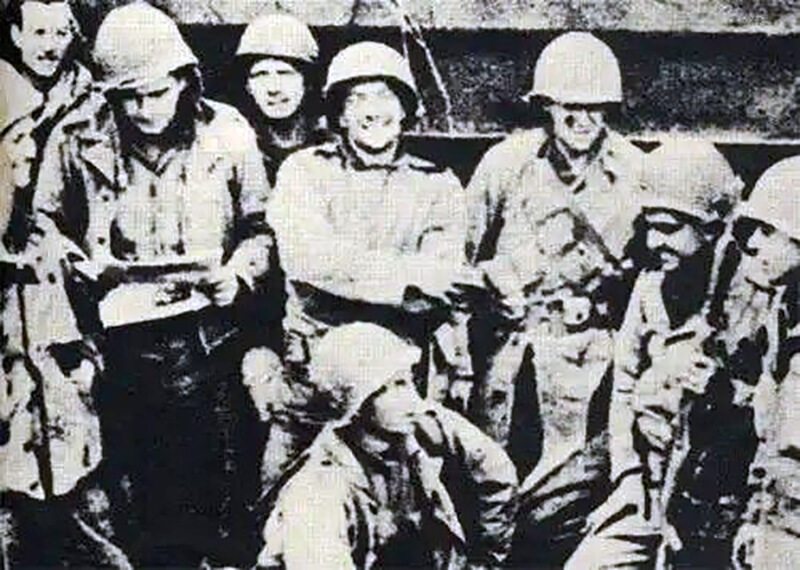

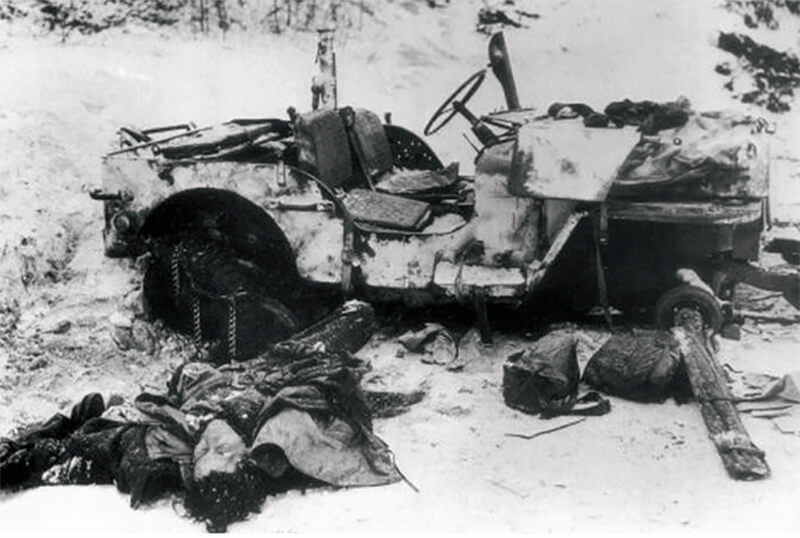

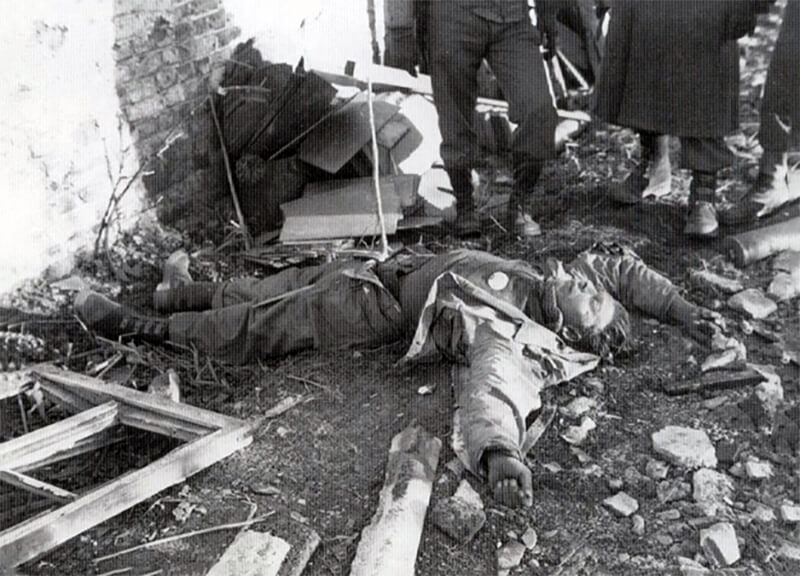
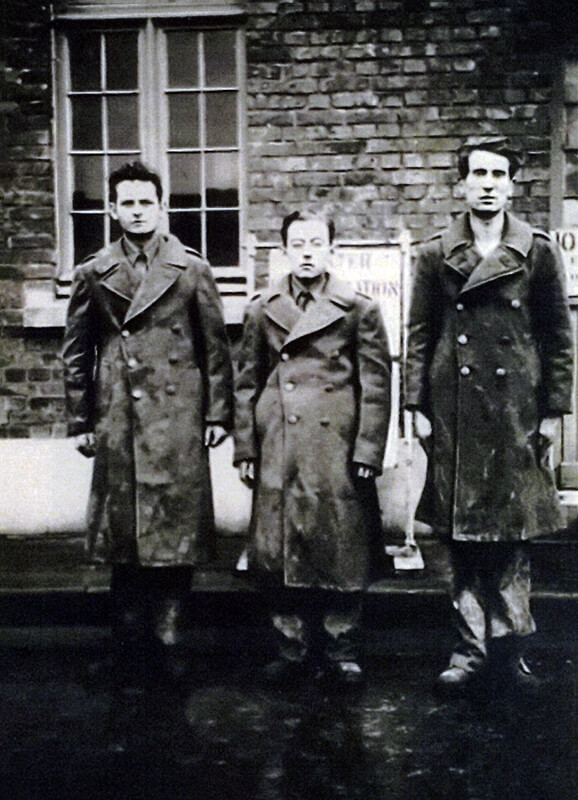
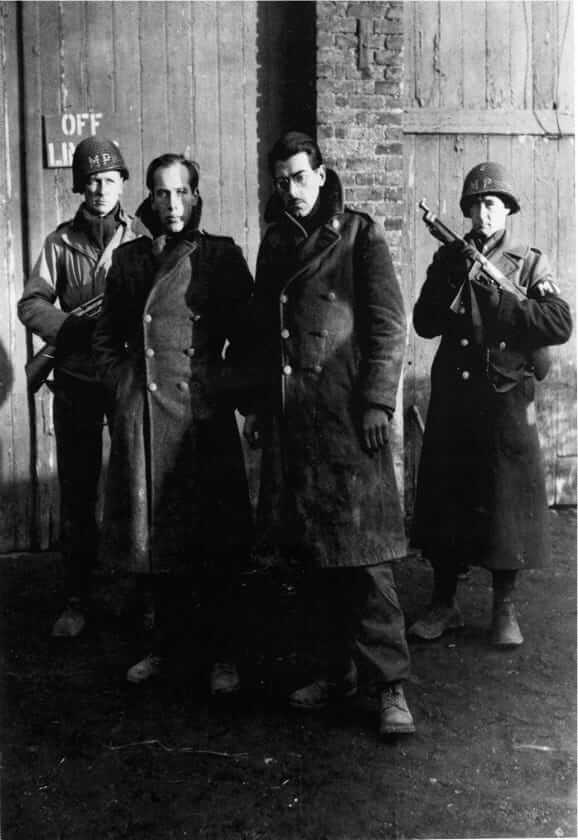
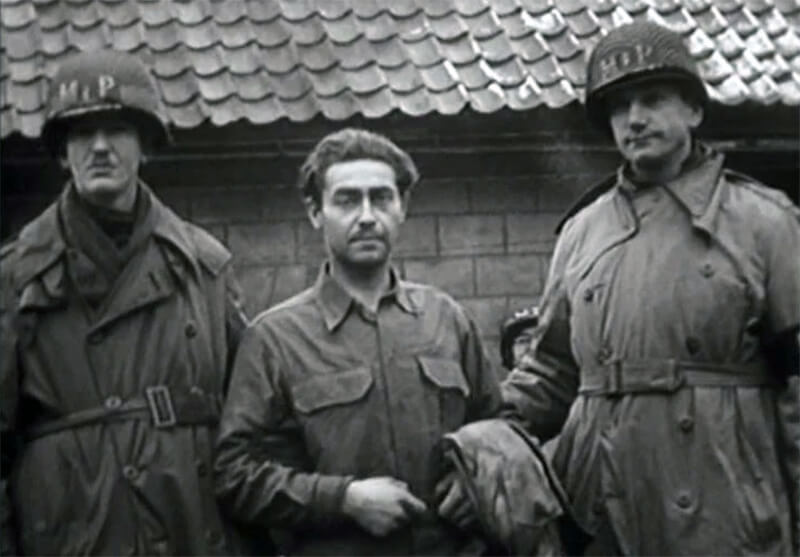
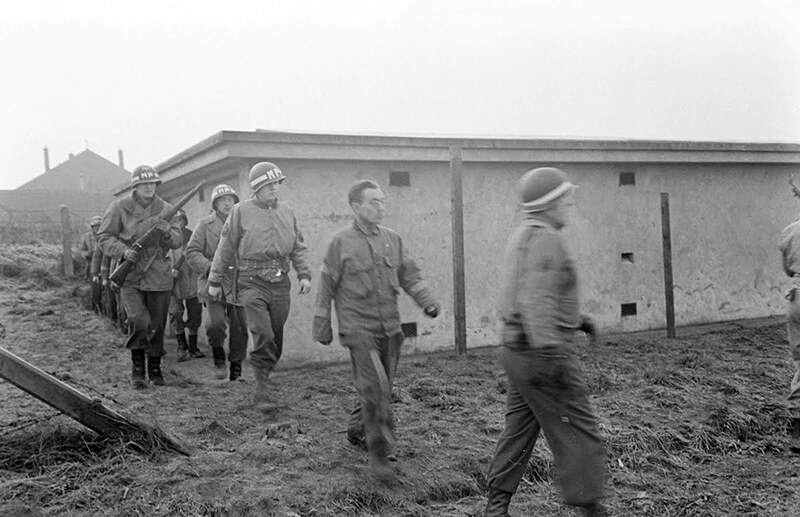

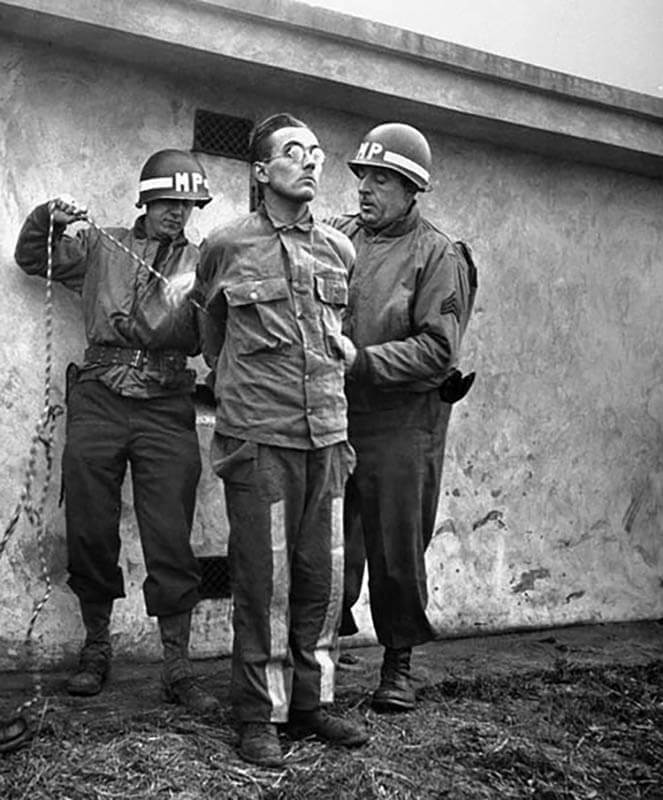
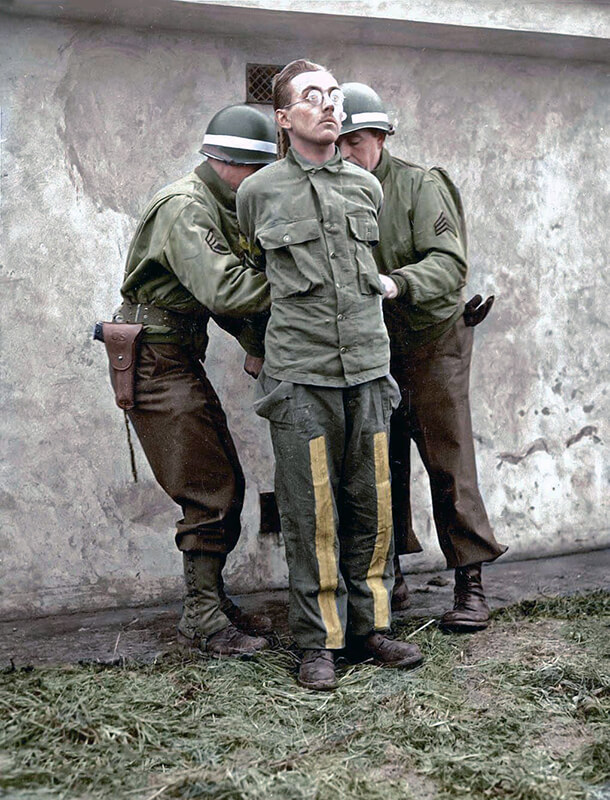
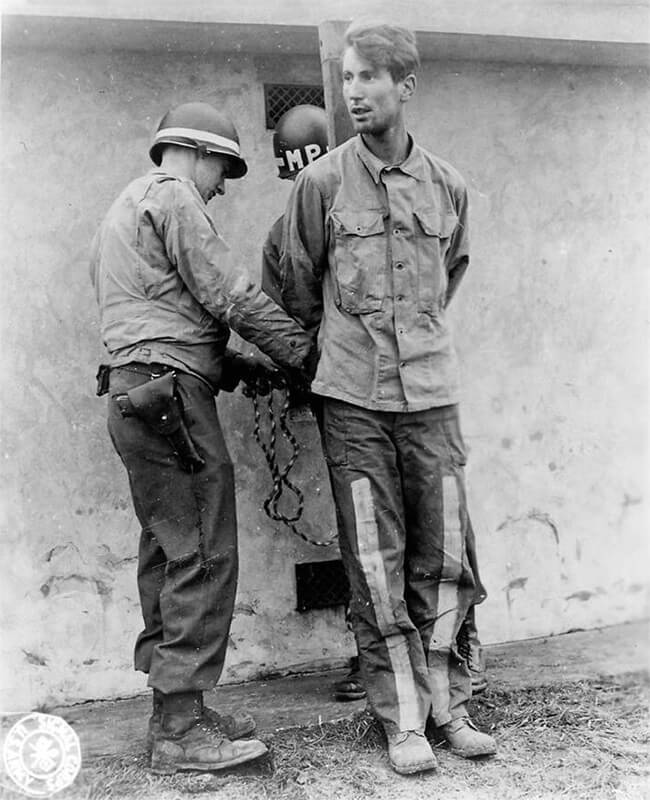

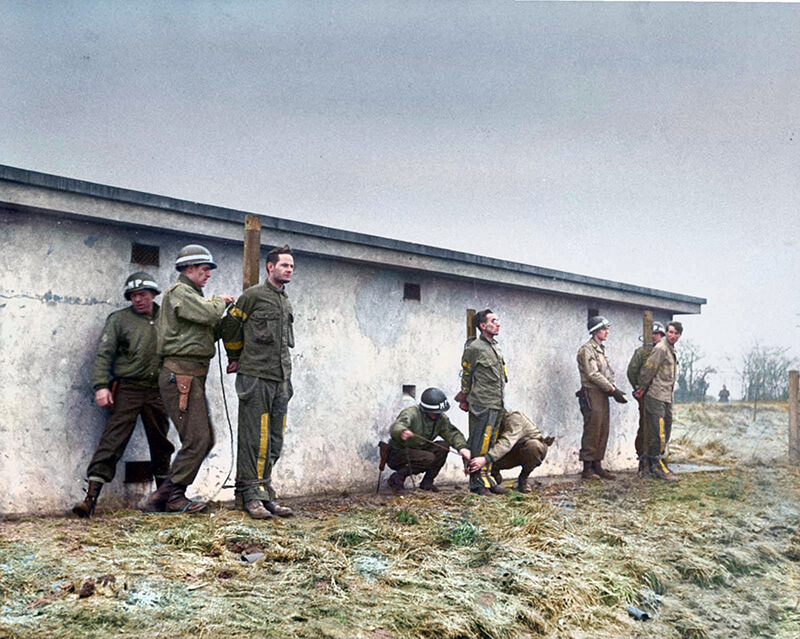
Unteroffizier Manfred Pernass, Oberfähnrich Günther Billing, and Gefreiter Wilhelm Schmidt
“They were captured on the 17th December 1944 and had ID cards with the following names ‘Charles W. Lawrence’, ‘Clarence van der Wert’ en ‘George Sensenbach’ but Pernass, Billing, and Schmidt were given a military trial at Henri Chapelle, sentenced to death, and executed by a firing squad. Captain J. Eiser (medical officer) of the 633th Medical Clearing Station pinned the white target patches on their chests, Schmidt’s glasses were taken off before he was shot and fanatic Billing shouted Long live our Führer Adolf Hitler, at the moment supreme.
